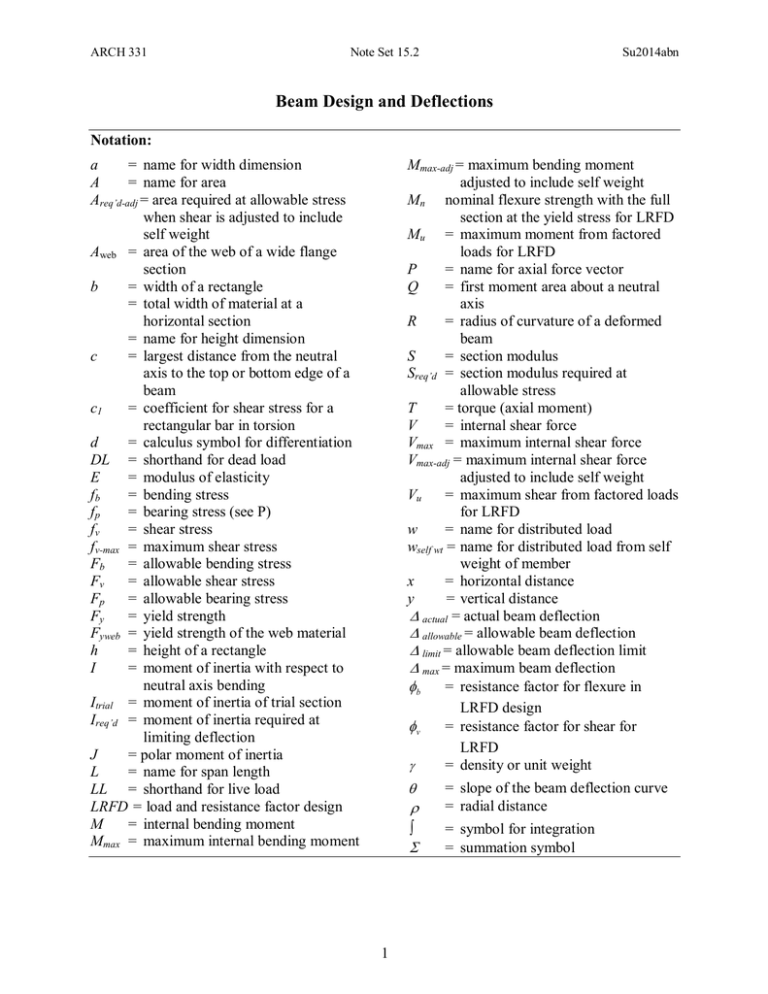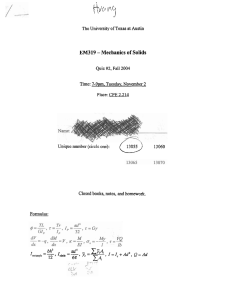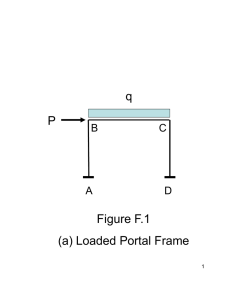Beam Design and Deflections
advertisement

ARCH 331 Note Set 15.2 Su2014abn Beam Design and Deflections Notation: a = name for width dimension A = name for area Areq’d-adj = area required at allowable stress when shear is adjusted to include self weight Aweb = area of the web of a wide flange section b = width of a rectangle = total width of material at a horizontal section = name for height dimension c = largest distance from the neutral axis to the top or bottom edge of a beam c1 = coefficient for shear stress for a rectangular bar in torsion d = calculus symbol for differentiation DL = shorthand for dead load E = modulus of elasticity fb = bending stress fp = bearing stress (see P) fv = shear stress fv-max = maximum shear stress Fb = allowable bending stress Fv = allowable shear stress Fp = allowable bearing stress Fy = yield strength Fyweb = yield strength of the web material h = height of a rectangle I = moment of inertia with respect to neutral axis bending Itrial = moment of inertia of trial section Ireq’d = moment of inertia required at limiting deflection J = polar moment of inertia L = name for span length LL = shorthand for live load LRFD = load and resistance factor design M = internal bending moment Mmax = maximum internal bending moment Mmax-adj = maximum bending moment adjusted to include self weight Mn nominal flexure strength with the full section at the yield stress for LRFD Mu = maximum moment from factored loads for LRFD P = name for axial force vector Q = first moment area about a neutral axis R = radius of curvature of a deformed beam S = section modulus Sreq’d = section modulus required at allowable stress T = torque (axial moment) V = internal shear force Vmax = maximum internal shear force Vmax-adj = maximum internal shear force adjusted to include self weight Vu = maximum shear from factored loads for LRFD w = name for distributed load wself wt = name for distributed load from self weight of member x = horizontal distance y = vertical distance actual = actual beam deflection allowable = allowable beam deflection limit = allowable beam deflection limit max = maximum beam deflection b = resistance factor for flexure in LRFD design v = resistance factor for shear for LRFD = density or unit weight 1 = slope of the beam deflection curve = radial distance = symbol for integration = summation symbol ARCH 331 Note Set 15.2 Su2014abn Criteria for Design Allowable bending stress or bending stress from LRFD should not be exceeded: Knowing M and Fb, the minimum section modulus fitting the limit is: Fb f b Mc I S req 'd M Fb Besides strength, we also need to be concerned about serviceability. This involves things like limiting deflections & cracking, controlling noise and vibrations, preventing excessive settlements of foundations and durability. When we know about a beam section and its material, we can determine beam deformations. Determining Maximum Bending Moment Drawing V and M diagrams will show us the maximum values for design. Remember: V (w)dx M (V )dx dV w dx dM V dx Determining Maximum Bending Stress For a prismatic member (constant cross section), the maximum normal stress will occur at the maximum moment. For a non-prismatic member, the stress varies with the cross section AND the moment. Deflections 1 M ( x) R EI If the bending moment changes, M(x) across a beam of constant material and cross section then the curvature will change: slope The slope of the n.a. of a beam, , will be tangent to the radius of curvature, R: y The equation for deflection, y, along a beam is: 1 M ( x)dx EI 1 1 dx EI EI M ( x)dx Elastic curve equations can be found in handbooks, textbooks, design manuals, etc...Computer programs can be used as well. Elastic curve equations can be superpositioned ONLY if the stresses are in the elastic range. 2 ARCH 331 Note Set 15.2 Su2014abn The deflected shape is roughly the shame shape as the bending moment diagram flipped but is constrained by supports and geometry. Boundary Conditions The boundary conditions are geometrical values that we know – slope or deflection – which may be restrained by supports or symmetry. At Pins, Rollers, Fixed Supports: At Fixed Supports: y=0 =0 At Inflection Points From Symmetry: =0 The Slope Is Zero At The Maximum Deflection ymax:. dy slope 0 dx Allowable Deflection Limits All building codes and design codes limit deflection for beam types and damage that could happen based on service condition and severity. ymax ( x) actual allowable L Use LL only Roof beams: Industrial L/180 Commercial plaster ceiling L/240 no plaster L/360 Floor beams: Ordinary Usage L/360 Roof or floor (damageable elements) DL+LL L/120 L/180 L/240 L/240 L/480 3 value ARCH 331 Note Set 15.2 Su2014abn Beam Loads & Load Tracing In order to determine the loads on a beam (or girder, joist, column, frame, foundation...) we can start at the top of a structure and determine the tributary area that a load acts over and the beam needs to support. Loads come from material weights, people, and the environment. This area is assumed to be from half the distance to the next beam over to halfway to the next beam. The reactions must be supported by the next lower structural element ad infinitum, to the ground. Design Procedure The intent is to find the most light weight member satisfying the section modulus size. 1. Know Fb (allowable stress) for the material or Fy & Fu for LRFD. 2. Draw V & M, finding Mmax. 3. Calculate Sreq’d. This step is equivalent to determining f b bh 2 4. For rectangular beams S 6 - - M max Fb S For steel or timber: use the section charts to find S that will work and remember that the beam self weight will increase Sreq’d. And for steel, the design charts show the wself wt A lightest section within a grouping of similar S’s. For any thing else, try a nice value for b, and calculate h or the other way around. ****Determine the “updated” Vmax and Mmax including the beam self weight, and verify that the updated Sreq’d has been met.****** 5. Consider lateral stability 6. Evaluate horizontal shear stresses using Vmax to determine if f v Fv 3V V VQ or 2 A Aweb Ib P f p Fp A f vmax For rectangular beams, W’s, and others: 7. Provide adequate bearing area at supports: 8. Evaluate shear due to torsion T T or Fv J c1 ab 2 (circular section or rectangular) fv 9. Evaluate the deflection to determine if max LL LLallowed and/or maxTotal T allowed **** note: when calculated > limit, Irequired can be found with: and Sreq’d will be satisfied for similar self weight ***** I req' d too big I trial lim it FOR ANY EVALUATION: Redesign (with a new section) at any point that a stress or serviceability criteria is NOT satisfied and re-evaluate each condition until it is satisfactory. 4 ARCH 331 Note Set 15.2 Su2014abn Example 1 (changed from pg 284) (superpositioning) 0.75 m C . Investigate using Beam Diagrams and Formulas. SOLUTION: By examining the support conditions, we are looking for a cantilevered beam from Cases 18 through 23. There is a case for uniformly distributed load across the span (19) and for a load at any point (21). For both these cases, it shows that the maximum shear AND maximum moment are located at the fixed end. If we add the values, the shear and diagrams should look like this: + V We can find the maximum shear (at B) from V = P + wl = 10 kN + 2kN/m3m = 16kN M + The maximum moment (at B) will be M = Pb+wl 2/2 = 10kN2.25m + 2kN/m(3m)2/2 = 31.5kN-m The key values for the diagrams can be found with the general equations (V x and Mx): VC = - wx = -2kN/m0.25m = -0.5kN; VC = -P – wx = -10kN - 2kN/m0.25m = -10.5kN MC = -WX2/2 = 2kN/m(0.25m)2/2 = 0.0625kN-m We can find the maximum deflection by looking at the cases. Both say max. (at free end), so the values can be added directly. Superpositioning of values must be at the same x location. Assume E = 70x103 MPa and I = 45x106 mm4 total Pb 2 6 EI (3l b) wl 4 8 EI kN 2 10 (2.25m) (10 3 3 mm m ) (10 3 N kN ) 6(70 10 MPa )(45 10 mm ) 3 6 4 (3 3m 2.25m) = 18.08 mm + 6.43 mm = 24.5 mm 5 2 kN m 4 (3m) (10 3 3 mm m ) (10 3 N kN ) 8(70 10 MPa )(45 10 mm ) 3 6 4 ARCH 331 Note Set 15.2 Su2014abn Example 2 (pg 275) (superpositioning) using Beam Diagrams and Formulas. SOLUTION: By examining the support conditions, we are looking for beam with an overhang on one end from Cases 24 through 28. (Even though the overhang is on the right, and not on the left like our beam, we can still use the information by recognizing that we can mirror the figure about the left end.) There is a case for a load at the end (26) but none for a load in between the supports. This is because it behaves exactly like a simply supported beam in this instance (no shear or bending on the overhang). The case for this is #5 (reversed again). If we “flip” the diagrams (both vertically and horizontally) and add the values, the resulting shear and bending moment should look like this: V + We still have to find the peak values of shear and the location of the zero shear to find the critical moment values. M + (Notice R1 is shown down.) R1 D Pa l wa 2l 2l a 10k 10 ft 20 ft 2 k ft 10 ft 2 20 ft 2 20 ft 10 ft 10k R2(B) 10 ft 2k / ft 10 ft 10k 20k (from the total downward load – R1(D)) VA = -10k VB = -10k + 20k = 10k VD = 10k – 2 k/ft(10ft) = -10k x (from B) = 10k/2k/ft = 5 ft MB = -10k(10ft) = -100k-ft (MC = -100k-ft + 10k(10ft) = 0) Mx = 0 +10k/ft(5ft)/2 = 25k-ft VMAX = 10 k MMAX = -100k-ft We can calculate the deflection between the supports. (And at the end for case 5 if we derive the slope!) Assume E = 29x103 ksi and I = 103 in4 We’ll investigate the maximum between the supports from case 26 (because it isn’t obvious where the maximum will be.) x l 3 20 total .06415 ft 3 Pal 2 EI k .06415 2 k / ft 11.55 wa 2 (to left of D) and total max . case 26 x case 5 ft l x 24 EIl ft ft 2 10 (10 )(20 ) (12 3 4 ft 2 ft ft 24(29 10 ksi )(103in )(20 ) (4 11.55 ft in / ft ) (29 10 ksi )(103in ) (10 ) (20 10 ) 3 4 xl 2 x 4 ft ft 2 a 2 Note: Because there is only negative moment, the deflection is actually up! 3 20 2(11.55 ) (10 ) )(12 ft 2 ft 2 in / ft ) 3 = -1.484 in + 1.343 in = -0.141 in (up) 6 with x (11.55ft) greater than a (10ft): 6 ARCH 331 Note Set 15.2 Su2014abn Beam Design Flow Chart Collect data: L, , , llimits; find beam charts for load cases and actual equations ASD LRFD Allowable Stress or LRFD Design? Collect data: Fb & Fv Collect data: load factors, Fy, Fu, and equations for shear capacity with V Find Vmax & Mmax from constructing diagrams or using beam chart formulas Find Vu & Mu from constructing diagrams or using beam chart formulas with the factored loads Find Sreq’d and pick a section from a table with Sx greater or equal to Sreq’d Pick a steel section from a chart having bMn Mu for the known unbraced length Calculate self wt. using A found and . Find Mmax-adj & Vmax-adj. Is Vu v(0.6FywebAweb) No Calculate Sreq’d-adj using Mmax-adj. Is Sx(picked) Sreq’d-adj? (OR calculate fb. Is fb Fb?) Yes No pick a section with a larger web area Yes Calculate Areq’d-adj using Vmax-adj. Is A(picked) Areq’d-adj? (OR calculate fv. Is fv Fv?) No pick a new section with a larger area Calculate max (no load factors!) using superpositioning and beam chart equations with the Ix for the section is max limits? This may be both the limit for live load deflection and total load deflection.) Yes (DONE) 7 I req' d too big limit I trial No pick a section with a larger I x



